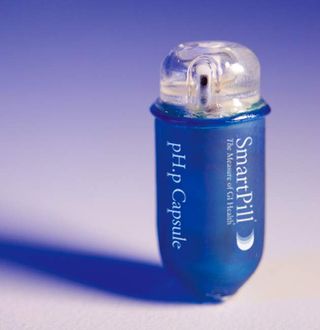Smart Pill to Report from Inside the Body

Soon Big Brother may be watching from the inside out. Like a Mars Orbiter beaming data back to Earth, a power-packed pill will soon be broadcasting from a stomach near you, transmitting both medical measurements and the device’s position as it travels through the body.
The 26-by-13-millimeter device, about the size of a multivitamin capsule, is designed to diagnose gastroparesis, or, in layman's terms, slow stomach emptying.
This condition, in which food stays in the stomach for more than four hours, is especially common in diabetics whose high blood sugar can destroy the stomach's vital vagus nerve, preventing stomach muscles from contracting. People who have gastroparesis can have such symptoms as a lack of appetite, vomiting, stomach spasms, bloating, and weight loss.
Better than ...
Currently, says David Barthel, president and CEO of the SmartPill Corporation, the company that makes the brainy capsule, gastroparesis patients must endure a gauntlet of invasive, expensive, and often inconclusive tests.
"They would go anywhere from an endoscope [in which a tube is passed through the mouth to the stomach], to a barium test [in which a thick liquid that shows up on X-rays is swallowed and tracked], to a gastric emptying centrifugy test," Barthel explains. "These patients will often run through all these procedures [and others] and it could take anywhere from six months to two years to accurately diagnose a motility patient."
The company's bionic pill is designed to replace this hodgepodge of tests, helping doctors diagnose the condition within days.
Sign up for the Live Science daily newsletter now
Get the world’s most fascinating discoveries delivered straight to your inbox.
As the plastic-sheathed pill passes through the stomach, intestines, and bowel, it transmits critical diagnostic information—such as pH, temperature, and the amount of pressure in the stomach and intestines—to a receiver that a physician later connects to a computer. Included in the digital signal is the pill's position in the body, giving doctors a clear picture of how effectively the stomach and other GI-tract components are pushing food toward the final destination.
Just passing through
The disposable $500 pill—which enters and exits the body through preexisting orifices—transmits data to a receiver that a patient wears either on a lanyard or attached to a belt.
But the transmitter's broadcast range is 5 feet, so a patient can remove the receiver to sleep or shower. Two tiny batteries power all of the pill's components, which are etched onto a single, custom-made chip, for at least five days.
The SmartPill Corporation, which began developing the device in 2003, has completed clinical trials in the United States, the FDA-controlled process in which human volunteers in hospital settings serve as subjects for new medical technologies or medicines. Based on these promising results, Barthel says, the Buffalo, NY-based company has applied for FDA approval to sell SmartPills in the United States and is in the process of applying for approval in European markets as well.
- Great Inventions: Quiz Yourself
- Fantastic Voyage to Save the Heart
- Implantable Lazy Susans Could Deliver Drug Cocktails
- Body Quiz 1: The Parts List
- Body Quiz 2: How the Parts Fit
Most Popular

